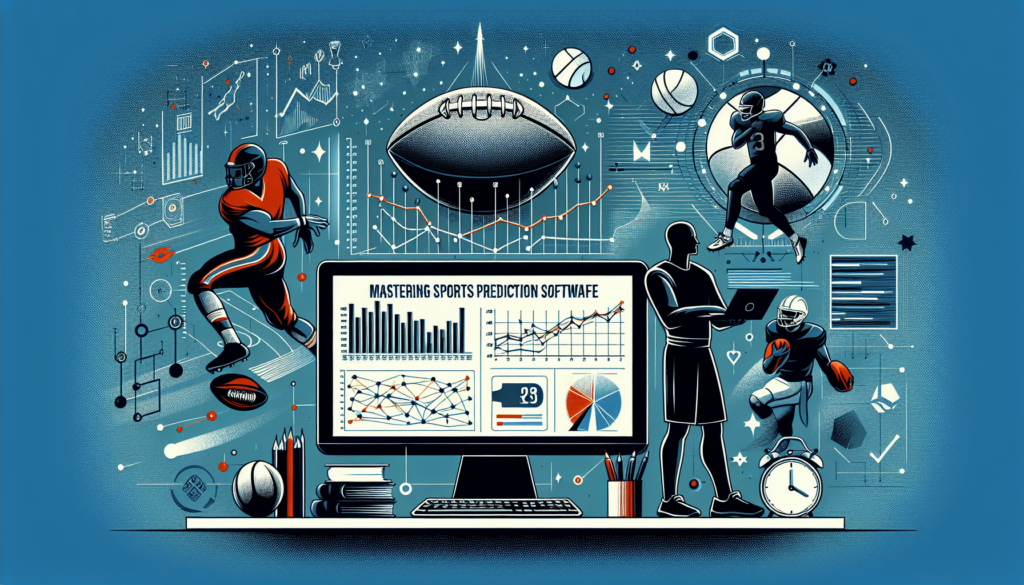Welcome to “Mastering Sports Prediction Software,” your ultimate guide to navigating and excelling with the latest tools in the realm of sports forecasting. In this brief yet comprehensive journey, you’ll uncover essential tips and strategies to optimize the use of sports prediction software, empowering you to make informed choices and elevate your game. Perfect for enthusiasts and professionals alike, this article equips you with the knowledge to harness advanced algorithms and data analysis, turning your predictions into winning insights. Have you ever wondered how some people seem to have a knack for predicting the outcome of sports events with uncanny accuracy? Maybe you’ve placed a bet on a team or player based on a hunch or emotional attachment and later regretted your decision. If this sounds familiar, it might be time for you to explore sports prediction software.
Welcome to “Mastering Sports Prediction Software.” In this article, we will delve into the world of sports prediction software and show you how to harness its power effectively. With the right tools and knowledge, you can make better-informed decisions and perhaps even turn a profit.

What Is Sports Prediction Software?
Sports prediction software is a technological tool designed to forecast the outcomes of sports events. By using complex algorithms, historical data, and real-time information, these programs can give you predictions that are often more accurate than mere guesswork. These tools can help you analyze various factors like team performance, player statistics, weather conditions, and even psychological aspects to improve your betting strategies.
How Does It Work?
The inner workings of sports prediction software involve a combination of advanced data analytics and machine learning algorithms. These systems continually refine their predictive capabilities by learning from past outcomes. Here’s a simplified look at how it generally works:
- Data Collection: The software gathers historical and real-time data from various sources.
- Data Cleaning and Processing: This raw data is then cleaned and processed to eliminate inconsistencies.
- Algorithm Application: Advanced algorithms are applied to the processed data to identify patterns and make predictions.
- Output Generation: The software generates predictions, often along with probabilities and confidence levels.
Why Use Sports Prediction Software?
You might ask, why should you use sports prediction software? There are several compelling reasons to consider:
- Accuracy: Machine-learning algorithms can process vast amounts of information much quicker and more accurately than a human can.
- Objectivity: The software is free from emotional biases, giving you a more rational basis for your bets.
- Time-Saving: It simplifies data analysis, allowing you to make informed decisions faster.
Features to Look for in Sports Prediction Software
Not all sports prediction software is created equal. Here’s what you should look for when choosing the right tool:
User-Friendly Interface
A good sports prediction software should have an intuitive, easy-to-navigate interface. You don’t want to waste time trying to figure out how to use the software. Clear dashboards, easy-to-understand metrics, and straightforward functionalities are critical.
Comprehensive Data Coverage
The quality of the predictions depends heavily on the data used. Make sure the software covers comprehensive data from various sports, leagues, and teams. The more extensive the data, the better the predictions.
Customizability
Look for software that allows you to input your own parameters and preferences. Customizability can significantly improve your predictions as you can tailor the software to focus on the metrics and factors most relevant to you.
Regular Updates
Sports are unpredictable, and new data constantly changes the landscape. Software that is regularly updated is more likely to give accurate predictions. Check to ensure the software has a robust system for regular updates.
How to Get Started
Getting started with sports prediction software is simpler than you might think. Here’s a step-by-step guide to help you begin your journey:
Step 1: Choose the Right Software
Do your research and select software that fits your needs and budget. Some popular options include Betegy, SportsLine, and Swish Analytics.
Step 2: Understand the Software
Take some time to go through tutorials and user guides. Knowing how to navigate the software will make it easier for you to utilize its features effectively.
Step 3: Input Your Data
Many programs allow you to input your own data or preferences. Whether it’s focusing on a particular type of sport or a specific set of metrics, customize the software to align with your needs.
Step 4: Analyze Predictions
Once you’ve inputted your data, use the software to generate predictions. Take the time to analyze these predictions and understand the confidence levels and probabilities provided.

Understanding Key Metrics
Metrics are essential in making sense of the predictions. Here are some crucial metrics you might come across:
Win Probability
Win Probability gives you the likelihood of a team or player winning an event. It’s often expressed as a percentage. Higher win probability suggests a higher chance of winning, making it a critical metric for decision-making.
Expected Goals (xG)
Expected Goals is a metric used primarily in soccer. It calculates the quality of scoring chances and the likelihood of scoring from those chances. This helps in understanding a team’s offensive and defensive capabilities better.
Against the Spread (ATS)
This metric is frequently used in sports like basketball and football. It shows how often a team covers the spread. A team with a good ATS record often performs better than expected.
Return on Investment (ROI)
ROI helps you gauge the profitability of your bets. It’s a straightforward metric to understand how much return you’re getting on your investments. Higher ROI means you’re making more money per unit wagered.
Table: Common Metrics
| Metric | Description | Importance |
|---|---|---|
| Win Probability | Likelihood of a team/player winning | Crucial for making informed bets |
| Expected Goals (xG) | Quality and likelihood of scoring chances | Helps evaluate offensive and defensive capabilities in soccer |
| Against the Spread (ATS) | How often a team covers the spread | Useful for sports like football and basketball |
| Return on Investment (ROI) | Profitability of bets | Measures how much return you get on your investments |
Advanced Techniques
Once you’re comfortable with the basics, you may want to explore more advanced techniques to further improve your predictions.
Machine Learning Models
If you have some technical know-how, you can leverage machine learning models to create custom predictions. Languages like Python and R have numerous libraries specifically designed for sports analytics.
Deep Learning
Deep learning can be used for more complex pattern recognition. This approach is especially useful for sports with a lot of variables, like football or basketball. Neural networks can help you identify intricate patterns that traditional models may miss.
Simulation Models
Monte Carlo simulations are a powerful tool in the field of sports predictions. These simulations run thousands of scenarios to calculate the likelihood of various outcomes, giving you a broader understanding of potential results.
Ethical Considerations
Using sports prediction software comes with a set of ethical considerations. Here’s what you need to keep in mind:
Responsible Gambling
Sports betting can be addictive. Always ensure you’re gambling responsibly. Set a budget and stick to it. Even with high-tech software, there’s always a risk involved.
Data Privacy
Make sure the software complies with data privacy laws. Your personal and financial information should be secure, and the software should be transparent about how your data is used.
Fairness
Ensure that the software is fair and unbiased. Some programs may have affiliations that could influence their predictions, so always double-check the source and methodology.
Troubleshooting Common Issues
Even the best sports prediction software isn’t perfect. Here’s how to deal with some common issues you might encounter:
Inaccurate Predictions
If you find the predictions consistently inaccurate, re-evaluate your data inputs and configuration settings. Sometimes, tweaking these parameters can improve the accuracy.
Software Bugs
Like any software, sports prediction tools may have bugs. Make sure you’re using the latest version and keep an eye out for patches and updates.
Data Discrepancies
If the data seems off, cross-reference it with other trusted sources. Inaccurate or outdated data can severely affect the predictions.
Future Trends
The world of sports prediction software is continually evolving. Here are some trends to watch for:
AI and Machine Learning
Artificial Intelligence and Machine Learning will continue to play a significant role, making predictions even more accurate and faster.
Real-Time Data Integration
Future software is likely to integrate real-time data more efficiently, allowing for instant updates and predictions based on the most current information.
Virtual and Augmented Reality
Imagine watching a game with real-time predictive analytics and insights overlaid via Augmented Reality (AR) glasses. This could revolutionize how we consume sports content.
Blockchain for Fairness and Transparency
Blockchain technology might be employed to ensure fairness and transparency. It can provide an immutable record of data and transactions, safeguarding against potential tampering.
Conclusion
Mastering sports prediction software can be a game-changer for sports enthusiasts and bettors alike. With the right tools and knowledge, you can make more informed decisions, improve your betting strategies, and perhaps even turn a profit. Remember to choose the right software, understand its features, and continually refine your approach. Most importantly, always gamble responsibly and keep ethical considerations in mind.
So, are you ready to elevate your game and make smarter bets? Happy predicting!




